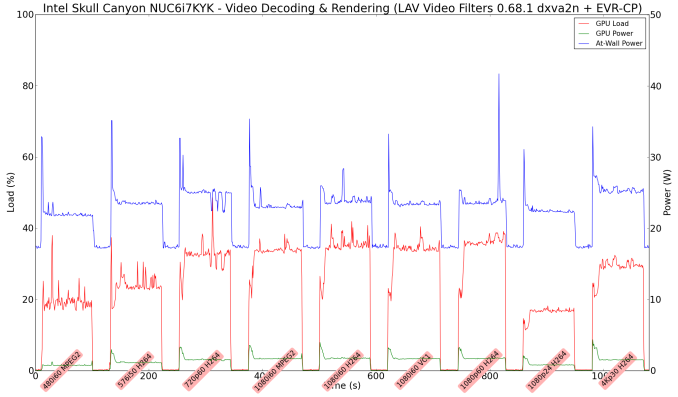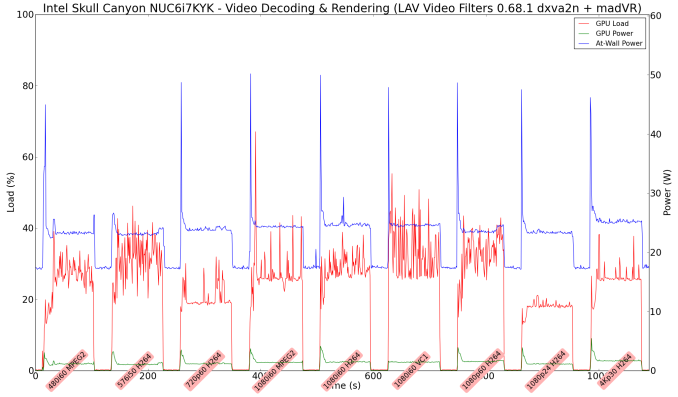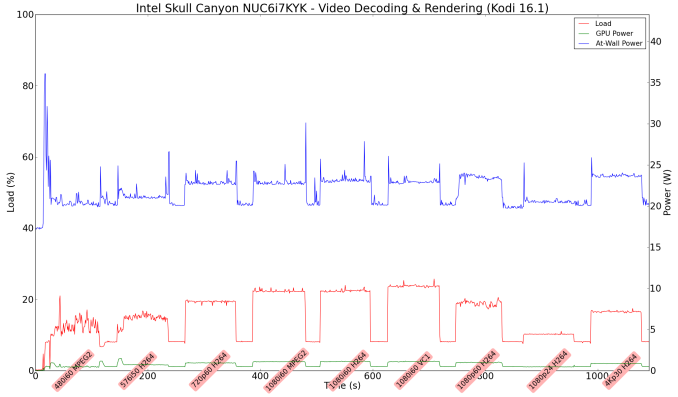The Intel Skull Canyon NUC6i7KYK mini-PC Review
by Ganesh T S on May 23, 2016 8:00 AM ESTHTPC Credentials
The higher TDP of the processor in Skull Canyon, combined with the new chassis design, makes the unit end up with a bit more noise compared to the traditional NUCs. It would be tempting to say that the extra EUs in the Iris Pro Graphics 580, combined with the eDRAM, would make GPU-intensive renderers such as madVR operate more effectively. That could be a bit true in part (though, madVR now has a DXVA2 option for certain scaling operations), but, the GPU still doesn't have full HEVC 10b decoding, or stable drivers for HEVC decoding on WIndows 10. In any case, it is still worthwhile to evaluate basic HTPC capabilities of the Skull Canyon NUC6i7KYK.
Refresh Rate Accurancy
Starting with Haswell, Intel, AMD and NVIDIA have been on par with respect to display refresh rate accuracy. The most important refresh rate for videophiles is obviously 23.976 Hz (the 23 Hz setting). As expected, the Intel NUC6i7KYK (Skull Canyon) has no trouble with refreshing the display appropriately in this setting.
The gallery below presents some of the other refresh rates that we tested out. The first statistic in madVR's OSD indicates the display refresh rate.
Network Streaming Efficiency
Evaluation of OTT playback efficiency was done by playing back our standard YouTube test stream and five minutes from our standard Netflix test title. Using HTML5, the YouTube stream plays back a 1080p H.264 encoding. Since YouTube now defaults to HTML5 for video playback, we have stopped evaluating Adobe Flash acceleration. Note that only NVIDIA exposes GPU and VPU loads separately. Both Intel and AMD bundle the decoder load along with the GPU load. The following two graphs show the power consumption at the wall for playback of the HTML5 stream in Mozilla Firefox (v 46.0.1).

GPU load was around 13.71% for the YouTube HTML5 stream and 0.02% for the steady state 6 Mbps Netflix streaming case. The power consumption of the GPU block was reported to be 0.71W for the YouTube HTML5 stream and 0.13W for Netflix.
Netflix streaming evaluation was done using the Windows 10 Netflix app. Manual stream selection is available (Ctrl-Alt-Shift-S) and debug information / statistics can also be viewed (Ctrl-Alt-Shift-D). Statistics collected for the YouTube streaming experiment were also collected here.

Decoding and Rendering Benchmarks
In order to evaluate local file playback, we concentrate on EVR-CP, madVR and Kodi. We already know that EVR works quite well even with the Intel IGP for our test streams. Under madVR, we used the DXVA2 scaling logic (as Intel's fixed-function scaling logic triggered via DXVA2 APIs is known to be quite effective). We used MPC-HC 1.7.10 x86 with LAV Filters 0.68.1 set as preferred in the options. In the second part, we used madVR 0.90.19.
In our earlier reviews, we focused on presenting the GPU loading and power consumption at the wall in a table (with problematic streams in bold). Starting with the Broadwell NUC review, we decided to represent the GPU load and power consumption in a graph with dual Y-axes. Nine different test streams of 90 seconds each were played back with a gap of 30 seconds between each of them. The characteristics of each stream are annotated at the bottom of the graph. Note that the GPU usage is graphed in red and needs to be considered against the left axis, while the at-wall power consumption is graphed in green and needs to be considered against the right axis.
Frame drops are evident whenever the GPU load consistently stays above the 85 - 90% mark. We did not hit that case with any of our test streams. Note that we have not moved to 4K officially for our HTPC evaluation. We did check out that HEVC 8b decoding works well (even 4Kp60 had no issues), but HEVC 10b hybrid decoding was a bit of a mess - some clips worked OK with heavy CPU usage, while other clips tended to result in a black screen (those clips didn't have any issues with playback using a GTX 1080).
Moving on to the codec support, the Intel Iris Pro Graphics 580 is a known quantity with respect to the scope of supported hardware accelerated codecs. DXVA Checker serves as a confirmation for the features available in driver version 15.40.23.4444.
It must be remembered that the HEVC_VLD_Main10 DXVA profile noted above utilizes hybrid decoding with both CPU and GPU resources getting taxed.
On a generic note, while playing back 4K videos on a 1080p display, I noted that madVR with DXVA2 scaling was more power-efficient compared to using the EVR-CP renderer that MPC-HC uses by default.




















133 Comments
View All Comments
jasonelmore - Monday, May 23, 2016 - link
it will work fine. Intel has been using the Razer External GPU Chassis and they even commented on it here on Anandtech Comments, on the last article that was posted about it. DMI 3.0 still does 4GB/s and the CPU is not transferring huge amounts of bandwidth hungry texture data back and forth with the CPUlmcd - Monday, May 23, 2016 - link
Plus the fact that PCIe 2.0 x4 was shown to be the tipping point between bandwidth limited and not for single GPU systems, I believe. 3.0 is twice that, and 2.0 4x barely even throttled that one graphics card -> there's a decent bit of overhead available.Cuhulin - Wednesday, May 25, 2016 - link
The only question I have about the Razer Core approach is price. Wouldn't it be better to simply buy a Razer Stealth instead?fanofanand - Monday, May 23, 2016 - link
Grandpa/Grandma don't need a 1k PC. They would be adequately served by the PC sticks. This would be massive overkill for Fakebook browsing. This is a product desperately searching for a niche market.gurok - Monday, May 23, 2016 - link
You say that, but they've incorporated a skull design specifically for grandpas/grandmas.Cuhulin - Wednesday, May 25, 2016 - link
Let's see whether you think the same way when you are a grandparent, or at least old enough to be one. I am a grandfather, and I need a decent PC for my 4k gaming, among other things - which means way more than 1k at this time. (I have at least 2k in the 3 4k monitors on my desk, for one thing). I suck at FPS games these days - reflexes just aren't what they were decades ago - but I still have fun. So maybe the ageism should be put away?Calista - Monday, May 23, 2016 - link
Why would you spend 1000 dollars on something a 300 dollar machine does almost just as well? No, this is a really an odd product which can't be upgraded, which can't play current games and which cost an arm and a leg. And why, to save a little bit of space on a desk already housing a (most likely) large monitor, large keyboard and a mouse. I could see the charm of something like this had we had easy access to MXM (or similar standard) modules. But for anyone else far better and almost as small options seem to exist.milkod2001 - Tuesday, May 24, 2016 - link
for $1000 one can get same specs laptop which comes with screen and keyboard already = much better buy/value.The only thing when NUCs make sense is if you need to hook it behind telly and use it as streaming device otherwise any other option gives you much more.
Calista - Tuesday, May 24, 2016 - link
Yeah. I have never understood this "I need a high-end PC, thus I buy an expensive PC which will only be high-end for the next 12 months" while keeping it for the next three years. Either we need high-end components and then we will always need the latest high-end components or else we don't need high-end components and then it doesn't make sense to buy expensive bleeding edge stuff.JBSZQn1LI06L8j33 - Tuesday, May 24, 2016 - link
i am thinking about it, but it is too expensive right now. it needs to be $400 and should come with windows usb. Right now it is basically laptop without keyboard, screen, touch-pad and external power supply. I really like the form factor ...